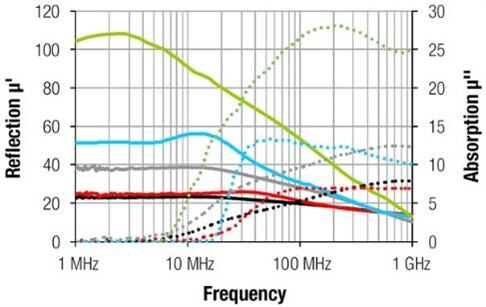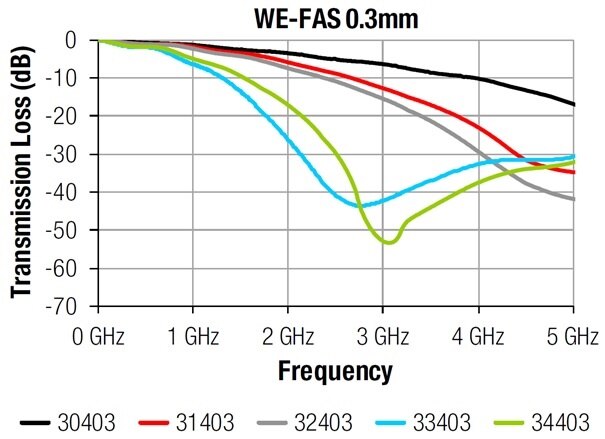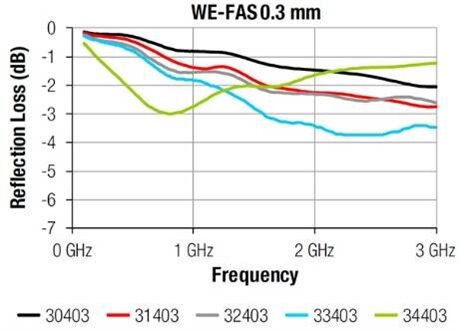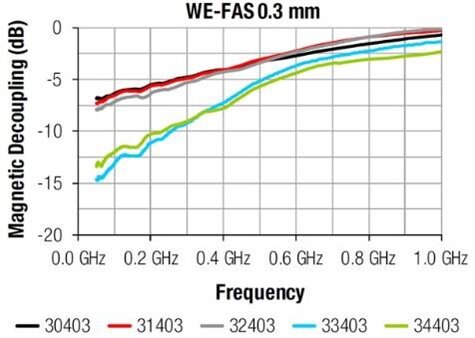Characterization Methods for Flexible Absorber Sheets WE-FAS
ANP059 // JORGE VICTORIA AHUIR
1. The Flexible Absorber Sheet WE-FAS
Electromagnetic Interference (EMI) has become a serious problem as it can occur anywhere in electronic circuits with unpredictable and detrimental effects. This issue has grown in recent years due to a number of factors including increases in device frequency, high integration in electronic systems, higher power densities and reductions in PCB thickness and size.
The most common means of solving electromagnetic noise problems is to shield the system with conductive materials such as shielded enclosures, foil tape or conductive gaskets. Nevertheless, a large number of electronic devices have many parts that operate at high frequencies that can cause complex EMI problems that cannot be removed with conductive shielding. In order to avoid these issues, Flexible Absorber Sheets, like the WE-FAS series, which is made of a polymer filled with ferrite powder material, can be used to suppress the unwanted high-frequency EM components.
Figure 1: WE-FAS Flexible Absorber Sheets
2. Absorber Sheet Properties
One of the most important parameters that describes the material’s ability to absorb direct and dissipated electromagnetic noise is represented by the part μ’’ of the complex permeability (μ). A material’s permeability is the result of molecular composition and structure and is defined as the complex permeability. The real part quantifies the stored energy or inductive component while the imaginary part quantifies the absorbed energy or absorption component:
| μr = μr'- jμr" | (Eq.1) |
The behavior of these parameters depends on the material composition and is frequency dependent. Thus, it is very important to know in which frequency range noise levels exceed maximum permitted limits. With this data, it is possible to establish a balance between reflection and magnetic losses depending on the application and the kind of electromagnetic noise. Figure 2 shows the complex permeability of several flexible absorber sheets of WE FAS series with different performance characteristics.
Figure 2: Permeability of flexible absorber sheet materials
As permeability is frequency dependent, the correct material need to be selected according to the frequency range where noise levels need to be suppressed. Standard specification don´t give this information. As they only state general parameters instead of absorption and reflection components:
| WE Part Number | Farnell Part Number | Thickness (mm) | μ’ typ @ 1MHz | Dimensions (mm) |
| 30403S | 3104225 | 0.3 | 23 | 330 x 210 |
| 30405S | 3104226 | 0.5 | 23 | 330 x 210 |
| 30410S | 3104227 | 1.0 | 23 | 330 x 210 |
| 31401 | - | 0.1 | 25 | 297 x 210 |
| 31402 | - | 0.2 | 25 | 297 x 210 |
| 31403 | - | 0.3 | 25 | 297 x 210 |
| 32401S | - | 0.1 | 39 | 297 x 210 |
| 32402S | - | 0.2 | 39 | 297 x 210 |
| 32403S | - | 0.3 | 39 | 297 x 210 |
| 32405S | - | 0.5 | 39 | 297 x 210 |
| 324075S | - | 0.75 | 39 | 297 x 210 |
| 32410S | - | 1.0 | 39 | 297 x 210 |
| 33401 | - | 0.1 | 55 | 297 x 210 |
| 33402 | - | 0.2 | 55 | 297 x 210 |
| 33403 | 3104181 | 0.3 | 55 | 297 x 210 |
| 34401 | 3104182 | 0.1 | 100 | 297 x 210 |
| 34402 | - | 0.2 | 100 | 297 x 210 |
| 34403 | 3104183 | 0.3 | 100 | 297 x 210 |
Tabel 1: Overview of WE-FAS series
Nevertheless, it can be difficult to estimate the absorber material performance as it is the result of a multitude of variables in addition to the absorber permeability. These include sheet thickness, size and geometry, as well as the distance between the noise source and absorber material. Thus, in basic systems the attenuation of a certain electromagnetic noise suppression material cannot be estimated. However, in order to study the effect in more complex electronic systems, it is often better to obtain real results through some experimental characterization techniques.
It is more interesting to measure the absorbing capacity through experimental setups that make it possible to evaluate the material performance of several sheets that demonstrate different behavior. Thereby, several experimental tests are described that can be used to characterize absorber materials based upon internal and external properties.
The characterization techniques described simulate specific Problems focused on transmission lines, cavity resonance and magnetic decoupling. These setups and experimental results will be shown below in order to determine which material provides the best performance to reduce electromagnetic noise problems depending on the application.
3. Microstrip Line Method
This technique makes it possible to evaluate the performance of the flexible absorber sheets in systems with transmission line issues through an experimental procedure. In this way, several sheets with different composition or thickness can be tested in order to obtain the Maximum transmission attenuation power ratio in a specific application.
These problems can appear in high-frequency data buses where digital signals switch in the frequency range of MHz or GHz that can produce conducted noise on the data lines. An interesting solution in this sort of application is to place an absorber sheet on the data bus as shown in Figure 3. This acts as a low-pass filter absorbing or attenuating high frequency conducted noise.
Figure 3: Transmission Line Application
A method based on a microstrip line (MSL) test fixture is used to evaluate the attenuation of conducting current noise in a PCB or noise path when the noise suppression sheet is in place. Thereby, the MSL is employed as transmission line, whereby a noise signal will be measured to know the ample absorption ability. Hence, this test fixture simulates a noise source inside an electronic circuit and it is therefore possible to determine the transmission absorption.
The manufactured MSL employed in this procedure consists of a PCB where the strip conductor is printed and two SMA type connectors are connected in both ends. The MSL is composed of polytetrafluoroethylene (PTFE) dielectric PCB material (length = 100 mm, width = 50 mm, thickness = 1.6 mm), a copper strip conductor (length = 54.4 mm, width = 4.4 mm, thickness = 0.018 mm) and a copper ground plane located in the bottom (length = 100 mm, width = 50 mm, thickness = 0.018 mm). The SMA connectors are installed on the opposite side of the MSL and they are connected with the end of the MSL through two vias. The absorbing ratio can be obtained by comparing the transmission line power ratio before and after installing the absorbing sheet on the test fixture. In order to carry out the measurements, each end of a network analyzer coaxial cable is connected to each SMA test fixture ports, as shown in Figure 4. The network analyzer has to be configured to operate as signal source and signal receiver through measuring the S21 parameters to start the measurement procedure.
Figure 4: Microstrip Line Measurement System
The results presented in Figure 5 show all available materials in 0.3 mm thickness which have been measured with the microstrip line Setup described above.
Figure 5: Transmission Coefficient as a Function of Different Materials
In the Appendix I you will find further data acquired of different materials with different thickness of the WE-FAS range. Considering this, it is possible to evaluate the Absorber materials Performance according to their composition and thickness.
4. Coaxial Line Method
Coaxial line experimental method provides a means of studying the noise suppression capabilities of the material to solve resonant cavity EMI issues. Cavity resonance is a problem that can appear when an electronic circuit is placed inside a metal enclosure. Noisy circuits usually cause the resonance inside the enclosure, which may cause interference problems or even generate a system malfunction. Considering this, after evaluating some absorber materials with several compositions and sheet thickness, it is possible to choose the sheet with the best performance to filter the resonant frequency. In this kind of application, a sheet is placed under the cover of the metal enclosure to absorb the electromagnetic noise as illustrated in Figure 6. A means of reducing these issues is to place an absorber sheet inside the enclosure to attenuate or suppress the resonance by reducing the internal reflections. To evaluate this material in this kind of application, an experimental measurement system based on a coaxial line is utilized. In this procedure, one terminal of the coaxial line is shorted with a metallic surface, and the reflected energy inside it is measured with a network analyzer, as shown in Figure 7.
In order to characterize the absorption capacity of different compositions and/or thicknesses, it is necessary to repeat the process setting the absorber material attached over the reflector and compare the results. The evaluation of absorber materials in this experiment is carried out by measuring the reflection parameter (S11) with the reference value set as the coaxial line without the absorber material. Next, the sample is placed between the reflection material and a reflective material before the measurement is made. By comparing reference and measured data, it is possible to study the performance of each sheet. The reflection attenuation measured with the experimental coaxial line method as shown in Figure 8 with 0.3 mm thickness. Again, several WE-FAS with different materials and thicknesses have been tested in the Appendix II in order to evaluate the attenuation ability in each case.
Figure 6: Coaxial Line Application
Figure 7: Coaxial Line Measurement Procedure
Figure 8: Reflection Attenuation of Different Compositions
5. Magnetic Decoupling Method
Magnetic decoupling is a common issue in electronic systems, which effects PCBs or devices with high-density layouts and circuits. This electromagnetic interference situation is often observed when there is a noisy electronic component or circuit placed on a PCB that can affect nearby elements and components. An interesting solution which can reduce the unintentional coupling of this kind is to focus on filtering the electromagnetic interference by placing the absorber sheet on the noise source or protecting the interfered part, as shown in Figure 9.
This technique analyzes the magnetic sheets absorption capacity for reducing or suppressing the coupling by employing a microstrip line test fixture to generate the EMI interference and a near field probe (NFP) to measure them. Thereby, this setup simulates a coupling system whereby one is used as a noise source and the other as a receiver or victim. The absorption effect is determined through connecting one port of the network analyzer to one terminal of the microstrip line and terminating the other connector with a load of 50 Ohm. Subsequently, the NFP is placed perpendicular to the track and connected to the second port of the network analyzer, as shown in Figure 10. Subsequently, a Network analyzer is configured as the signal source and signal receiver and the S21 parameters are compared before (reference) and after placing each absorber sheet on the microstrip line. The measured data with the absorber sample in place is subtracted from the reference.
Figure 9: Magnetic Decoupling Applications
Figure 10: Magnetic Decoupling Measurement Technique
Data obtained through the magnetic decoupling technique is represented in Figure 11. The graph chart shows the measurement of WE-FAS with different material in 0.3 mm thickness. More graph charts in the Appendix III Show the data also for the different thickness.
Figure 11: Magnetic Decoupling as a Function of Sheet Materials
6. Summary
Taking everything into consideration, WE-FAS Flexible Absorber Sheets can solve a variety of EMI problems in different kinds of applications. Thereby, absorber materials have been characterized in order to be employed in applications with data buses affected by conducted problems, electronic circuits located inside an enclosure with malfunctions due to cavity resonance and electromagnetic interference between components placed in the same circuit or in close proximity to it. Absorber sheets can provide several advantages in controlling EMI. This is confirmed with experimental techniques, which provide results in terms of attenuation ratio depending on the kind of problem therefore demonstrating the best option to use when solving a specific EMI problem. Furthermore, several thicknesses have been evaluated to demonstrate the performance of different products depending on the device space limits. Therefore, these materials can provide an innovative, straightforward solution without the need to modify or redesign the electronic circuit or product.
A. Appendix
A.1. Appendix I - Transmission coefficient as a function of sheet thickness
 A.2. Appendix II - Reflection coefficient as a function of sheet thickness
A.2. Appendix II - Reflection coefficient as a function of sheet thickness
 A.3. Appendix III - Magnetic Decoupling as a function of sheet thickness
A.3. Appendix III - Magnetic Decoupling as a function of sheet thickness
| WE Part Number | Farnell Part Number | Thickness (mm) | μ’ typ @ 1MHz | Dimensions (mm) |
| 30403S | 3104225 | 0.3 | 23 | 330 x 210 |
| 30405S | 3104226 | 0.5 | 23 | 330 x 210 |
| 30410S | 3104227 | 1.0 | 23 | 330 x 210 |
| 31401 | - | 0.1 | 25 | 297 x 210 |
| 31402 | - | 0.2 | 25 | 297 x 210 |
| 31403 | - | 0.3 | 25 | 297 x 210 |
| 32401S | - | 0.1 | 39 | 297 x 210 |
| 32402S | - | 0.2 | 39 | 297 x 210 |
| 32403S | - | 0.3 | 39 | 297 x 210 |
| 32405S | - | 0.5 | 39 | 297 x 210 |
| 324075S | - | 0.75 | 39 | 297 x 210 |
| 32410S | - | 1.0 | 39 | 297 x 210 |
| 33401 | - | 0.1 | 55 | 297 x 210 |
| 33402 | - | 0.2 | 55 | 297 x 210 |
| 33403 | 3104181 | 0.3 | 55 | 297 x 210 |
| 34401 | 3104182 | 0.1 | 100 | 297 x 210 |
| 34402 | - | 0.2 | 100 | 297 x 210 |
| 34403 | 3104183 | 0.3 | 100 | 297 x 210 |
IMPORTANT NOTICE
The Application Note is based on our knowledge and experience of typical requirements concerning these areas. It serves as general guidance and should not be construed as a commitment for the suitability for customer applications by Würth Elektronik eiSos GmbH & Co. KG. The information in the Application Note is subject to change without notice. This document and parts thereof must not be reproduced or copied without written permission, and contents thereof must not be imparted to a third party nor be used for any unauthorized purpose.
Würth Elektronik eiSos GmbH & Co. KG and its subsidiaries and affiliates (WE) are not liable for application assistance of any kind. Customers may use WE’s assistance and product recommendations for their applications and design. The responsibility for the applicability and use of WE Products in a particular customer design is always solely within the authority of the customer. Due to this fact it is up to the customer to evaluate and investigate, where appropriate, and decide whether the device with the specific product characteristics described in the product specification is valid and suitable for the respective customer application or not.
The technical specifications are stated in the current data sheet of the products. Therefore the customers shall use the data sheets and are cautioned to verify that data sheets are current. The current data sheets can be downloaded at www.we-online.com. Customers shall strictly observe any product-specific notes, cautions and warnings. WE reserves the right to make corrections, modifications, enhancements, improvements, and other changes to its products and services.
WE DOES NOT WARRANT OR REPRESENT THAT ANY LICENSE, EITHER EXPRESS OR IMPLIED, IS GRANTED UNDER ANY PATENT RIGHT, COPYRIGHT, MASK WORK RIGHT, OR OTHER INTELLECTUAL PROPERTY RIGHT RELATING TO ANY COMBINATION, MACHINE, OR PROCESS IN WHICH WE PRODUCTS OR SERVICES ARE USED. INFORMATION PUBLISHED BY WE REGARDING THIRD-PARTY PRODUCTS OR SERVICES DOES NOT CONSTITUTE A LICENSE FROM WE TO USE SUCH PRODUCTS OR SERVICES OR A WARRANTY OR ENDORSEMENT THEREOF.
WE products are not authorized for use in safety-critical applications, or where a failure of the product is reasonably expected to cause severe personal injury or death. Moreover, WE products are neither designed nor intended for use in areas such as military, aerospace, aviation, nuclear control, submarine, transportation (automotive control, train control, ship control), transportation signal, disaster prevention, medical, public information network etc. Customers shall inform WE about the intent of such usage before design-in stage. In certain customer applications requiring a very high level of safety and in which the malfunction or failure of an electronic component could endanger human life or health, customers must ensure that they have all necessary expertise in the safety and regulatory ramifications of their applications. Customers acknowledge and agree that they are solely responsible for all legal, regulatory and safety-related requirements concerning their products and any use of WE products in such safety-critical applications, notwithstanding any applications-related information or support that may be provided by WE.
CUSTOMERS SHALL INDEMNIFY WE AGAINST ANY DAMAGES ARISING OUT OF THE USE OF WE PRODUCTS IN SUCH SAFETY-CRITICAL APPLICATIONS.
USEFUL LINKS
Application Notes: www.we-online.com/app-notes
REDEXPERT Design Tool: www.we-online.com/redexpert
Toolbox: www.we-online.com/toolbox
Produkt Katalog: www.we-online.com/products
DIRECT LINK
ANP059: Characterization Methods for Flexible Absorber Sheets WE-FAS
CONTACT INFORMATION
Würth Elektronik eiSos GmbH & Co. KG
Max-Eyth-Str. 1, 74638 Waldenburg, GERMANY
Tel.: +49 7942 945 - 0
Email: appnotes@we-online.com
Web: www.we-online.com














Top Comments